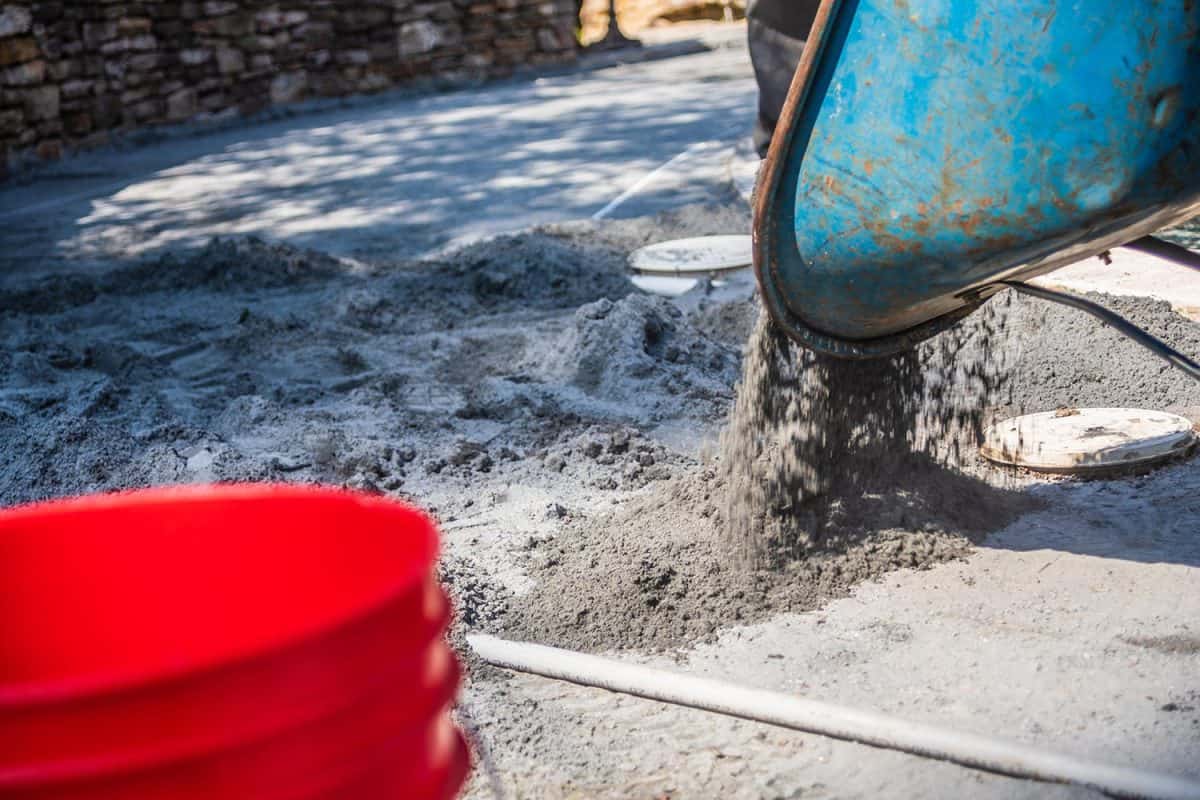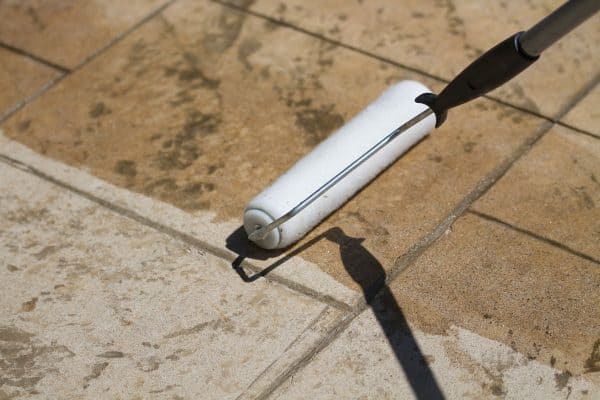Disclosure: We may get commissions for purchases made through links in this post.
In paver installation, the sand is one of the major materials used. The purpose of the sand is crucial in pavers because it acts as a foundational piece and serves as a glue in keeping them together. However, choosing what sand to use in joints can be confusing to homeowners. You may ask, what are the types of sand used for paver joints? Here is what we got for you.
The most common and widely used types of paver joint sands are concrete sand, masonry sand, and polymeric sand. These sands are applied over the surface of the pavers to fill in the spaces between joints. Joint sands are usually paired with a joint-stabilizing sealer to achieve more stable and long-lasting pavers.
Curious to know what type of joint sand is best to use? Read on to know more about them, their differences, and their pros and cons.
![Pile of silica sand used as a material for backfilling the joints between the tiles of concrete gray interlocking paving on the construction site, Types Of Paver Joint Sand [Considering The Pros & Cons Of Each]](https://pavingplatform.com/wp-content/uploads/2022/03/Types-Of-Paver-Joint-Sand.-800x1200.png)
What Is Paver Joint Sand And Its Applications?
As the name suggests, joint sands are used to stabilize and prevent your pavers from moving away from each other. These sands fill the gaps between your pavers and the friction of the sands helps it lock the pavers in place. However, as your pavers are exposed to seasonal changes, strong winds, and runoff over time, you may need to regularly refill the gaps to avoid pavers shifting.

What Are The Types Of Paver Joint Sands - Pros And Cons?
1. Concrete Sand

Concrete sand, commonly referred to as washed concrete sand, is the most widely used type of sand when it comes to paver installations. Here are a few pros and cons of concrete sand to help you decide.
Pros
Coarser Texture
Compared to other types, concrete sand has a coarser and more granular texture which helps the pavers bind together compared to smooth, homogenous sand particles.
Versatile
Not only does concrete sand function as joint sand but it can also be used as your base where your pavers are laid. In addition, it is the most common sand type mixed with cement to produce concrete, hence the name.
Cons
Easily Eroded
One of the drawbacks of concrete sand if used as paver joint sand is that it erodes easily. Because of its large particles, it can't be easily compacted hence, when hit by heavy rain, some particles are eroded and sometimes washed together with the runoff.
Monotonous Appearance
Because concrete sand only comes in one color- mostly gray, it is hard to blend it if the pavers are in a different color.
2. Masonry Sand
Also known as mason sand or mortar sand, this type is finer in texture compared to concrete sand. Here are a few pros and cons of masonry sand.
Pros
Alternative For Concrete Sand
If concrete sand is not available, you can use masonry sand instead to do the job for you. Although it is finer and more uniform in texture, it can still be used as joint sand for pavers. Because of its finer particles, it makes your pavement look smooth and uniform.
Versatile
Like concrete sand, masonry sand also has a wide variety of uses. It can be used for projects that don't require any specific type of sand. Like concrete sand, you can also use it as a base for your pavers and joint sand at the same time.
Not Easily Eroded Compared To Concrete Sand
Due to its fine particles, masonry sand can be easily compacted creating a tighter and less permeable layer that is not easily washed away.
Cons
Not Durable
While it can be used as joint sand, masonry sand can't hold pavers for a long period. Because of its fine texture, the sand particles don't have sharp edges that create more friction to hold the pavers in place.
Maintenance Can Be Expensive
Although it is not new that paver joints should be refilled over time, the cost of refilling your joints can accumulate more cost if you're doing it in a span of just a few years.
3. Polymeric Sand
In recent years, a new way to fill paver joints has emerged. Polymeric sand is a synthetic product made from mixing fine sand particles and some additives- mainly silica. The additives function as the binding agent that creates a permanent bond between the sand particles when added with water. Here are a few pros and cons of polymeric sand.
Pros
Durable
One major advantage of polymeric sand is when applied properly, it can last up to 10 years. However, the lifespan of this type still depends on the quality of the product used.
Appearance
Polymeric sand comes in various colors. Thus, it is easier to match it with your paver color for that seamless and uniform look.
Withstand Extreme Weather Conditions

Unlike concrete and masonry sands, erosion is not an issue when it comes to polymeric sand. When exposed to water, this type does not dissolve and can adapt to the expansion and contraction that happens between seasonal changes.
Prevent Growth of Weeds And Ants

We can all agree that weeds are not a good sight to see in our patios or driveways. Fortunately polymeric sand prevents the growth of weeds and ants because of its impermeable characteristic where water can't seep through.
Cons
Expensive
One drawback of using polymeric sand is its cost. Given that it's man-made and is combined with additives, it is anticipated that polymeric sand is expensive. However, through its stellar quality and performance as paver joint sand, one can say that polymeric sand is worth every penny.
Click here for this white polymeric sand on Amazon.
Why Is Paver Joint Sand Combined With Sealers?
Sealing pavers before you can use them is essential when it comes to the paver installation. It strengthens the bond and reduces the loss of your paver joint sand particles. Another advantage of sealing is it saves you money in the long run and reduces your time in maintenance because it prolongs the lifespan of your pavers.
Not only does it help in enhancing the colors of your pavers, but it also serves as a barrier that protects your pavers from moisture and UV rays. It also stops the growth of mold, weeds, and algae, especially in humid areas.
However, if exposed to constant rain and sunlight, sealers can wear off over time so sealing should be done periodically.
Click here for this joint stabilizing sealer on Amazon.
What Type Of Paver Joint Sand Is Best To Use?
With its promising results in keeping the pavers steady and in place, most contractors recommend polymeric sand as the best paver joint sand to use. Given its durability and other advantages, investing in polymeric sand sounds like the right thing to do when constructing a long-lasting paving project. Polymeric sand is also DIY friendly so application is not a problem.

Final Thoughts
Choosing what type of joint sand to use in your pavers is critical if you want your pavers to stand the test of time. You must carefully weigh each of the pros and cons in deciding what type to use. Investing in good quality joint pavers saves you money and time which are two important things to consider in every project.
If you are having problems with the setting of your polymeric sand, you can read this article on why your polymeric sand is not hardening.
On the other hand, if you're looking for other alternatives to fill in your paver joints, you can read this article about using stone dust between pavers.



![Vibrant Red Paver Stone Path, Can You Spray Paver Sealer? [How To Apply It]](https://pavingplatform.com/wp-content/uploads/2022/04/Vibrant-Red-Paver-Stone-Path-600x400.jpg)
![Properly laid out red pavers for a garden, Can You Tint Paver Sealer? [And How To]](https://pavingplatform.com/wp-content/uploads/2022/04/Properly-laid-out-red-pavers-for-a-garden-600x400.jpg)
